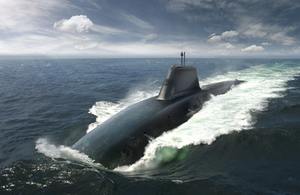
The sun's beginning to set on Britain's vaunted fleet of Vanguard-class nuclear missile submarines. Image source: CPOA(Phot) Tam McDonald/MOD for U.K. Ministry of Defence.
Three months ago, Britain promised America that it would do its part to defend NATO from outside threats, devoting 2% of its gross domestic product, or about $59 billion annually, to defense spending. This week, we learned what it will be spending some of those billions on:
Nuclear-powered submarines, stuffed to the gills with nuclear missiles.
A one-legged stool
Unlike the U.S. nuclear arsenal, which is built upon a "triad" of land-based, air-launched, and submarine-carried nuclear missiles, Britain's entire nuclear deterrent is carried by its four Vanguard-class nuclear missile submarines (SSBNs). The first Vanguard entered service more than two decades ago, however, and was designed with an anticipated service life of just 25 years. That estimate has since been amended to keep the boat in service through 2024 -- but even so, the clock is clearly ticking on this delivery system, and it's time for Britain to seek a replacement. Meanwhile, Russia recently announced plans to build eight new SSBNs of its own.
As reported by USNI News (the publishing arm of the U.S. Naval Institute) this week, the British government has "guaranteed" the Royal Navy that it will replace all four aging Vanguard-class boats. Citing Russia's plans to justify its own investment, the Ministry of Defence (MoD) assured the Royal Navy that it will replace the Vanguards with an equal number of new class of submarine, dubbed the "Successor" class.
Here's what we know about it.
Introducing the Successor Class
Planned to enter service in 2028, the Successor class of SSBN will be built largely by three of Britain's biggest defense contractors: BAE Systems (BAESY 0.80%), Rolls-Royce (RYCEY +0.50%), and Babcock International. Construction of the first submarine will begin in September 2016, but that boat won't enter service until 12 years later.

Artist's concept of Vanguard's replacement, the Successor-class SSBN. Source: UK Government.
Each of these vessels will weigh in at 16,000 tons displacement, and carry as many as 16 Trident II D5 nuclear-tipped missiles. (Current plans anticipate a standard deployment with only half the vessel's missiles nuclear-armed -- but carrying as many as 40 nuclear warheads among them.) The Successors will share a Common Missile Compartment (CMC) system for carrying these missiles, developed in cooperation with America's General Dynamics Corporation (GD +0.47%). General Dynamics is designing the CMC to equip America's own next-generation ballistic missile submarine, the SSBN(X).
Final details on the submarine's development are still in flux. But it seems BAE Systems will have overall responsibility for building the Successors, with Rolls-Royce and Babcock presumably collaborating on the engines and power plant.
The numbers...
According to the BBC, the UK has already spent about $1.1 billion on development of the Successor class since the project first got underway back in 2007. Roughly half that money has gone to BAE Systems, Rolls-Royce, and Babcock & Wilson. Going forward, though, future funds should tilt increasingly in favor of BAE Systems as the Successor's lead contractor -- although Babcock, Rolls, and General Dynamics will certainly get their fair shares as well.
As for how much money is up for grabs, MoD estimates that a fleet of four Successors will cost it between $19.8 billion and $25.2 billion for the submarines themselves. Total revenue up for grabs could surpass $36 billion, including the cost of arming the submarines and putting in place the infrastructure to build them. So all in, we're looking at a total program cost of roughly $9 billion per SSBN.
...and what those numbers mean for taxpayers and investors
Meanwhile, here on this side of the pond, the U.S. Navy is hard at work designing a "successor" submarine of its own, the SSBN(X), which will replace America's fleet of Ohio-class ballistic missile submarines. Similar in size to the Successor class, and similar in mission, each Ohio-class boat is expected to cost between $6.6 billion and $7.7 billion. Depending on which costs get factored into those prices, therefore, it looks like Britain's Successors could cost it anywhere from 25% less to 36% more, per boat, than the American equivalent.
So what might Britain do to bring its costs down a bit, while continuing to ensure it possesses an effective at-sea nuclear deterrent? The way I look at it, the big difference between these two programs is this:
According to data from S&P Capital IQ, BAE earns an average of just 11% profit per revenue dollar on its defense business, whereas General Dynamics earns 12.6%. That leaves more room for cost-cutting at the U.S. defense contractor (benefiting taxpayers), while still leaving room for profit-making (benefiting shareholders). If British taxpayers should balk at the cost of their new $9 billion submarines, therefore, one obvious solution might be to expand the "Common Missile Compartment" program between SSBN(X) and Successor into a common submarine building program between General Dynamics and BAE.
By partnering with General Dynamics, perhaps on a "You build one, then we build one" project to equip both navies with new submarines, BAE could cut its program costs significantly. Taking advantage of both General Dynamics' greater profitability, and adding production scale, U.S. and UK taxpayers could reap savings (and General Dynamics and BAE Systems shareholders could reap profits) in the process.
Is it a far-fetched idea? Perhaps. But in an era of tough economic times, and shrinking defense budgets, it's an idea worth exploring. With more than 12 years until the first Successor needs to float, we've got more than enough time to discuss it.
USS Ohio (SSBN-726/SSGN-726), built and remodeled by General Dynamics' Electric Boat. Image source: U.S. Navy.

